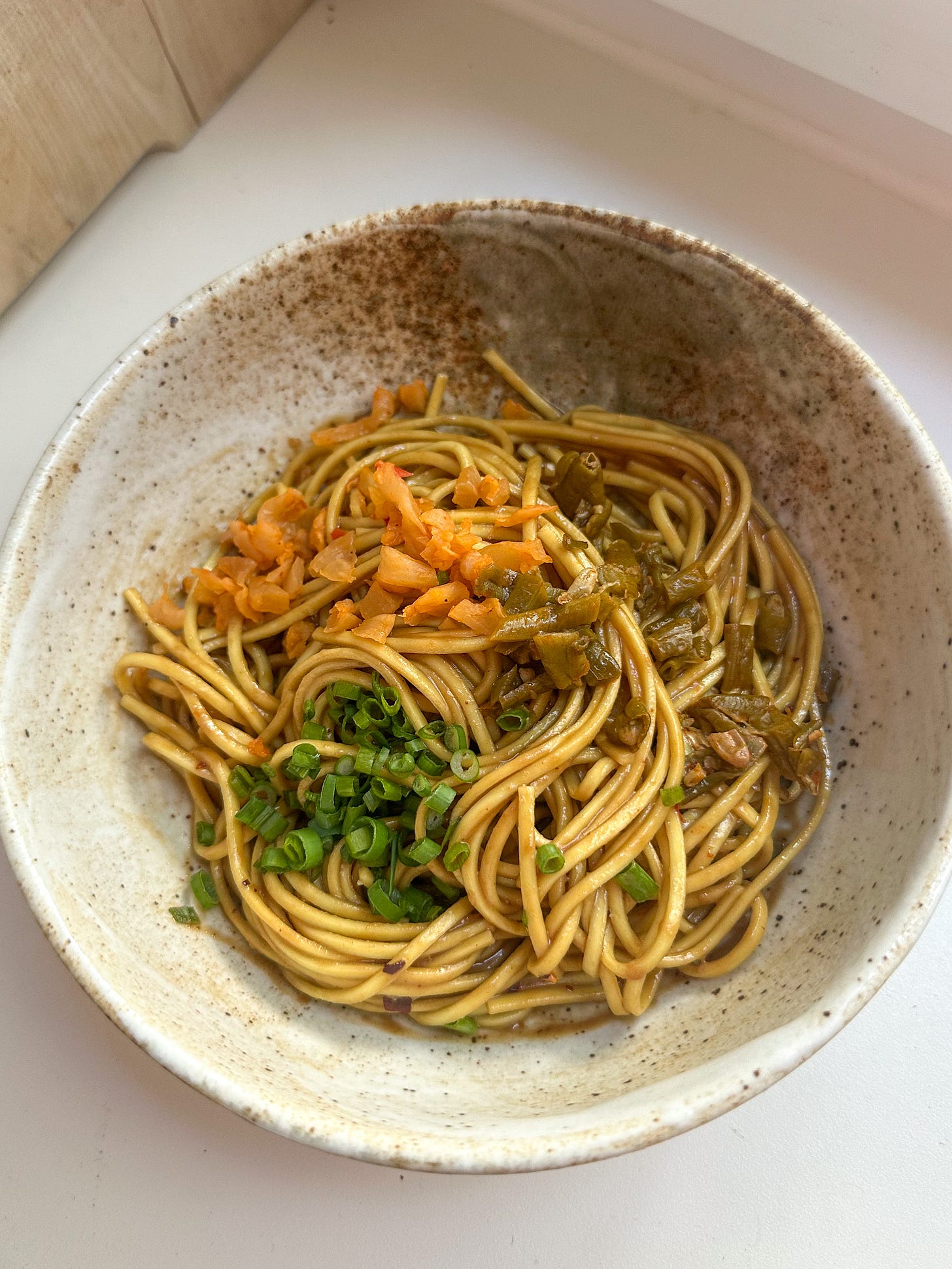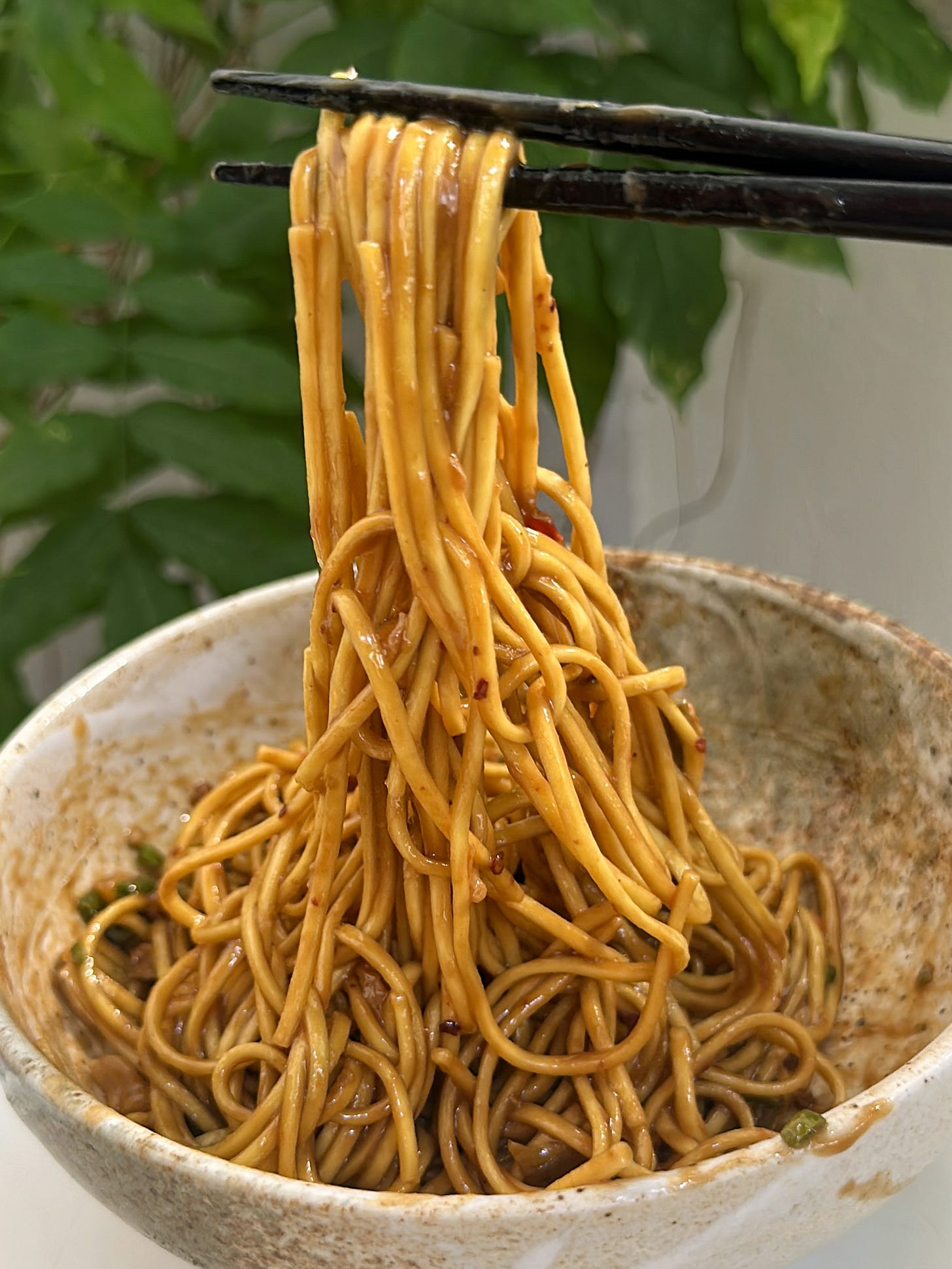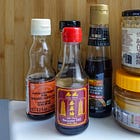Hi! While I’m still (slowly) working on the rest of the travel content, I’m back with another recipe from my regional Chinese noodle series from last year. I’ve written about five regional noodle dishes (more can be found in my recipe index), including Beijing’s fried sauce noodles, Yunnan’s small pot rice noodles, and Cantonese wonton noodles.
My newfound obsession with sesame paste began after I researched it intensively, and was recently sparked by a bowl of sesame noodles I had in Shanghai. I feel compelled to work on one of China’s most famous sesame noodle dishes: re gan mian (热干面), or “hot dry noodles,” the beloved breakfast staple of Wuhan and the Hubei province. As its name suggests, it’s a bowl of springy, dry-tossed alkaline noodles, topped with crunchy pickles, fresh scallions, and a generous swirl of silky sesame paste.
The port city on the Yangtze River is famous for its breakfast culture, known locally as guo zao (过早), which translates to “spend the morning”, a vivid phrase that captures the lively ritual of grabbing a quick bite from a street stall before disappearing into the crowd. The lineup includes everything from mian wo 面窝 (fried donut-shaped pastry) and dou pi 豆皮 (savory mung bean and soy bean crepes) to mi baba 米粑粑 (sticky rice cakes). Many locals pair a bowl of hot dry noodles with hot soy milk or dan jiu 蛋酒, an egg drop sweet soup with fermented rice, made by pouring boiling water over a freshly cracked egg.
I’d even argue that re gan mian is one of the easiest Chinese noodle dishes to make at home. It’s naturally meatless (and fully vegan if you skip the beef stock), and doesn’t call for anything fancy. Hearty and satisfying, it mirrors my impression of Wuhan itself: generous, bustling, and full of warmth.
I was only in Wuhan once more than two decades ago, when the Three Gorges Dam hadn’t yet been built, and my family took a cruise from Chongqing to Wuhan along the Yangtze River and visited scenic river towns on the route that sadly no longer existed. So my recollection of eating re gan mian there was faint at best. Luckily, I have two friends in Berlin who are from Wuhan and Hubei province, and helped me test this recipe (big thanks to Buyan, who came by for a taste test, and Junshun, who is a talented food creative behind famous for my dinner parties, for many tips!).
Hot Dry Noodles 丨热干面 (Rè Gān Miàn)
Serves: 1
Ingredients:
80g dry (or 120g fresh) alkaline noodles
1 tbsp spicy preserved daikon radish (luobogan) or zhacai
1 tbsp preserved long beans (suandoujiao)
2 tsp Chinese sesame paste
2 tsp sesame oil
1 clove garlic, crushed
1 tsp water
1 tsp light soy sauce
½ tsp Chinese black vinegar (preferably Chinkiang)
1 tsp scallion green, finely sliced
⅛ tsp chicken bouillon powder
⅛ tsp MSG
½ tsp chili oil (optional)
lushui braising liquid (optional, see note)
Instructions:
Prepare sesame sauce: In a small bowl, combine sesame paste with an equal amount of oil from the jar (or extra sesame oil). Whisk until smooth and thin, like runny yogurt. Stir in soy sauce, vinegar, and chili oil.
Prep toppings: Chop preserved daikon radish and long beans into small pieces. Combine crushed garlic with 1 tsp water. Slice scallions into fine rings.
Cook noodles (first time): Bring a large pot of water to a boil. Cook noodles until about 70% done (1-2 minutes before the suggested cooking time). Drain, reserving cooking water. Toss noodles with ½ tsp sesame oil and spread them out on a big plate. Toss with chopsticks to cool and dry (use a fan for quicker cooling).
Cook noodles (second time): Briefly blanch noodles in boiling water (about 20 seconds). Drain and transfer to a bowl.
Add chicken powder, MSG, soy sauce, garlic water, and vinegar to the noodles. Drizzle with sesame sauce. Top with scallions, preserved radish, long beans, crushed peanuts, and optional lushui or chili oil. Mix and eat while hot.
Tips for Making Hot and Dry Noodles
The Braising Liquid (Lushui)
According to my friend Junshun from Wuhan, adding lushui (卤水), a fragrant braising liquid with soy sauce and spices, is a relatively recent evolution. Around the early 2000s, breakfast shops began expanding their menus to include braised tofu, beef, and other items, and some started drizzling lushui over the noodles to enhance the flavor. However, purists often divide the dish into “wet”(湿派) and “dry” styles (干派) , with some firmly preferring their noodles without any added broth. Pickled long beans are also a more recent addition. If you have leftover braising liquid from making beef or ribs, a spoonful or two is perfect. Otherwise, you can make a simple version in under 20 minutes.
Simple Braising Liquid:
Heat 1 tsp oil in a small pot. Add 1 chopped scallion and 3 slices of ginger. Toss in 1 star anise, 1 small piece of Chinese cinnmaon stick, ½ tsp Sichuan peppercorns, ½ tsp fennel seeds, 1 bay leaf, and 1 dried chili. Fry briefly until aromatic. Pour in 1 cup water and ½ cup store-bought beef or vegetable stock, then stir in 1 tbsp soy sauce, 1 tsp dark soy sauce, and 1 tsp sugar. Bring to a boil, then simmer 15–20 minutes. Strain before using. This can be saved in the fridge to flavor other noodles.
Noodles and the Double-Cooking Method
I use the same thick alkaline wheat noodles I recommend for Yibin burning noodles, either dried or fresh (in this case, dried round ones worked even better). You can also substitute other chewy wheat noodles, or even thin pasta like capellini.
One distinctive feature of Re Gan Mian is the double-cooking method. First, you cook the noodles until about 70–80% done, then toss them with sesame oil and spread them out to cool completely (sometimes with the help of a fan), a process known as dan mian (掸面). This step, similar to how cold noodles are made in Sichuan, gives the noodles a pleasant chew and prevents sticking. Vendors often prepare large batches this way ahead of time, blanching the noodles quickly to reheat just before serving. The result is springy noodles that stay separate and absorb the thick sesame sauce beautifully.
Sesame Paste and the Toppings
Pure Chinese sesame paste needs to be thinned gradually until smooth and glossy, almost like pourable yogurt. I find a small whisk works great here. If you’re using a mixed sesame paste (often blended with 20–30% peanut), it will thin out more easily, but the color will be paler. Some shop also uses black sesame paste.
Read more about sesame paste:
Every shop has its own set of toppings, and many let diners customize their bowls. Most classic versions include spicy luobogan, 萝卜干 (preserved daikon radish), and suandoujiao, 酸豆角 (pickled long beans), both found in most Asian groceries. If you can’t find them, preserved mustard stem (zhacai) is a good substitute.
Read more about different types of Chinese preserved vegetables:












Yummy.
With an abundance of noodle dishes using different types and flavours...do you have a favourite?